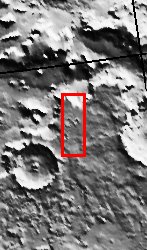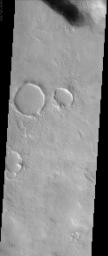- Original Caption Released with Image:
-

(Released 25 April 2002)
The Science
This THEMIS visible image shows a region in northern Arabia Terra near 44° N, 322° W (38° E). Knobby or "scabby" plains units that mantle and modify a pre-existing cratered surface dominate the unusual landscape in this region. Several large (5-8 km diameter) impact craters seen in the upper left of the image have been extensively modified since their initial formation. The rims of these craters can still be seen, but the ejecta deposits and the surrounding plains have been buried by a layer of material. This mantling layer has itself been modified to produce a pitted, knobby surface. Circular depressions of all sizes, presumably the remnants of impact craters, are filled with smooth deposits. In some places large regions have been covered by this smooth material; an example can be seen in the lower right portion of this image. In many cases the impact craters have been extensively modified prior to their being filled. This modification indicates an erosion process that has removed material from the walls to produce shapes that vary from circular with crisp rims, to circular with no rims, to oblong and elliptical forms, and finally to irregular shapes whose initial circular outline can barely be detected. The slope of the channel at the top of the image has an unusual deposit of material that occurs preferentially on the cold, north-facing slope. Similar deposits are seen frequently at mid-northern and southern latitudes on Mars, and have a characteristic, rounded boundary that typically occurs at approximately the same distance below the ridge crest. It has been suggested that these deposits once draped the entire surface and have since been removed from all but the cold north-facing slopes. The presence and removal of ground ice may play an important role in the formation of this layer, as well as the knobby terrain and unusual features seen in this image.
The Story
There's no way these impact craters are in their original, pristine shape. Check out their strange deformities and register the geological gross-out factor of all the "scabs" upon the land. You can still see the rims of craters in this savaged land, but an aggressive layer of material once spread out across it, burying the ejected material and all the surrounding plains. This cloaking layer didn't win the battle of dominance, however, as it too has been battered over time, producing the pitted, knobby surface seen today.
Only a few smooth deposits in the area are spared from the scabby, scarred look of the long barraged (see lower right portion of the image). Circular depressions, the probable remains of impact craters, are filled with this smooth material. Some were already well eroded prior to being filled, with material removed from their walls used to sculpt the varying shapes.
The dark, shadowed channel at the top of this image has an unusual deposit of material on its cold, north-facing slope. Since this material is found elsewhere on Mars, at approximately the same distance below the ridge crest, could it have draped the entire surface of Mars long ago? Why has it been lost from all but the northern slopes? Could ice in the ground play a role in forming and preserving this layer? And did it craft the knobby terrain and other strange features in this area?
These are the kinds of questions geologists are asking. As this image proves, the more you discover, the more questions you have. That's what keeps exploration so exciting.
- Image Credit:
-
NASA/JPL/Arizona State University
Image Addition Date: -
2002-05-23
|

 Planetary Data System
Planetary Data System













